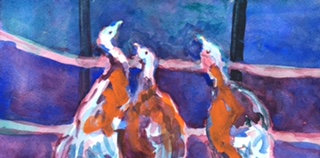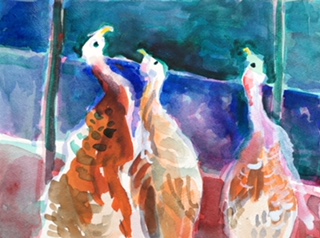by Rain Trueax
Every
now and again an opportunity arises for a guest author to come here and
share their books. I have read Shanna's romances and like how they
depict the West. Then I learned she was bringing this nonfiction book out for
Christmas and was looking for blogs to share it; I was very interested.
That she is donating part of its proceeds to help rodeo cowboys (don't
forget I just had a book out on them), well, it was a total win/win for
Rainy Day Thought. I think you will find A Cowboy Christmas as interesting as I do. Never too early to start to build some Christmas spirit-- especially with so much going on that can drain that from us.
Read a Book, Help a Cowboy
For most rodeo athletes it is
a matter of when they get hurt, not if.
Many are uninsured and for
those who find themselves out of work for months on end, the injury can be
devastating physically, emotionally, and financially.
That’s where the Justin Cowboy Crisis Fund steps in. The JCCF provides financial
assistance to rodeo athletes who’ve sustained catastrophic injuries that leave
them unable to compete for an extended time. Rather than worry about how
they’ll pay their bills, they can focus on healing.
Because she grew up around
cowboys and loves to include them in the stories she writes, author Shanna
Hatfield supports the JCCF through her Read
a Book, Help A Cowboy
campaign. In its sixth year, the campaign raises funds and awareness for the
JCCF. Now through Christmas Eve, Hatfield will donate ten percent of the
proceeds from every book purchase to the JCCF.
A wonderful addition to this year’s
campaign is Hatfield’s brand-new book called
A Cowboy Christmas. The book features 300 pages of
western holiday fun with more than 70 full-color recipes.
The jangle of spurs mingles with
the jingle of sleigh bells in this celebration of Christmas—
cowboy style!
Welcome home to a western holiday with
A Cowboy Christmas.
A collection of unique holiday décor, traditions, recipes, and guides for
entertaining with ease make this your go-to resource for an amazing western
Christmas. Filled with stories of real-life ranch families and rodeo cowboys,
get a glimpse into their traditions, try their family recipes, and experience
their lifestyles. From preserving memories of the past to tips for wrapping
presents, discover the special touches incorporated throughout this book that
make it a holiday keepsake you’ll cherish for years to come. Brimming with
holiday cheer, recipes with full-color photographs, and one-of-a-kind ideas,
this book is a wonderful celebration of the holidays that will help make your
Christmas unforgettable.
This book is available from:
About the Author:
USA Today bestselling author Shanna Hatfield is a farm girl who loves to
write. Her sweet historical and contemporary romances are filled with sarcasm,
humor, hope, and hunky heroes. When Shanna isn’t dreaming up sassy characters,
twisting plots, or testing out new recipes, she hangs out with her beloved
husband, Captain Cavedweller. She resides near Walla Walla, Washington.
RECIPE
Chocolate
Chex Trees
These yummy and adorable trees are so simple to make and a great
project if you have kids at home who need something to do. Set them on a
disposable plate, foil-wrapped piece of cardboard, or a large sugar cookie
wrapped in cellophane for gift-giving!
Ingredients:
3 cups Chex Chocolate cereal
6 pretzel sticks (the thick kind, made for dipping)
½ cup peanut butter
¼ cup Nutella
3 tablespoons butter, softened
1 cup powdered sugar
Directions:
Mix the peanut butter, Nutella, butter,
and powdered sugar in a bowl.
On whatever you plan to use for a base,
mold the peanut butter mixture around the pretzel stick until it stands upright
and forms a slight cone shape.
Hold it steady by using the tip of the
pretzel as a handle and begin inserting pieces of cereal into the peanut butter
mixture in a symmetrical pattern around the stick. You can tip the cereal
pieces up or down, depending on your personal preference. Add more cereal
pieces, staggering them as you move upward, until you get near the top.
For the top of the tree, use broken
pieces or cut them in half to get the smaller scale of branches near the top.
Use two pieces of cereal back to back to
form the top.
Dust with powdered sugar.
Makes 6 trees
PRAISE
"Absolutely one of the best Christmas entertaining books I
have ever read or seen I would hold this up against even Southern Living’s
Christmas book they put out every year and that’s saying a huge thumbs up for A
Cowboy Christmas. The recipes are all easy and quick sounding which is always
the type of recipe I love to use. Once again Shanna Hatfield is the best at
what at she does!"
Goodreads Reviewer
"Such a beautiful book, and such a wonderful celebration of
traditions and ideas to introduce into your own family. Included are
heartwarming stories, recipes, craft ideas. This book shares with Shanna
Hatfield's readers her joy and enthusiasm for the Western Way of life and the
continuity of family that needs to be handed down to the new generations."
Amazon Reviewer
 The first turkey painting to the right consists of a build up of layer upon layer of washes using the the 1/2" Simply Simmons 1 stroke plat long . During the process I would put a wash on and then leave it to do some mundane household task, coming back for another wash when the painting was completely dry. I became fond of this synthetic hair brush. In this painting I felt it was forced
The first turkey painting to the right consists of a build up of layer upon layer of washes using the the 1/2" Simply Simmons 1 stroke plat long . During the process I would put a wash on and then leave it to do some mundane household task, coming back for another wash when the painting was completely dry. I became fond of this synthetic hair brush. In this painting I felt it was forced  In the second painting of turkeys using the Simply Simmons 1/2 inch flat, my initial drawing in paint did not go well, so on subsequent layers I was able to draw a new outer edge of the turkeys' heads. The right angle of the brush's tip lent itself to making angular shapes in the drawing and in filling in the background helping to unify the paintings. The lighter early drawing left a nice transition from the very dark background to the very white of the head giving the head a three dimensional form.
In the second painting of turkeys using the Simply Simmons 1/2 inch flat, my initial drawing in paint did not go well, so on subsequent layers I was able to draw a new outer edge of the turkeys' heads. The right angle of the brush's tip lent itself to making angular shapes in the drawing and in filling in the background helping to unify the paintings. The lighter early drawing left a nice transition from the very dark background to the very white of the head giving the head a three dimensional form. 

